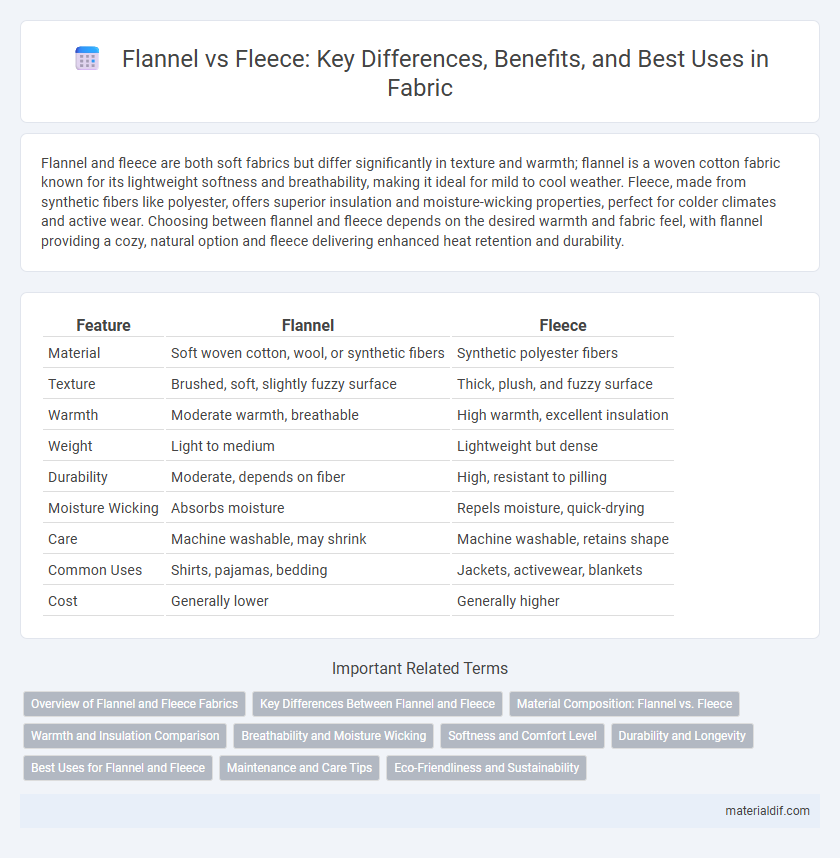Flannel and fleece are both soft fabrics but differ significantly in texture and warmth; flannel is a woven cotton fabric known for its lightweight softness and breathability, making it ideal for mild to cool weather. Fleece, made from synthetic fibers like polyester, offers superior insulation and moisture-wicking properties, perfect for colder climates and active wear. Choosing between flannel and fleece depends on the desired warmth and fabric feel, with flannel providing a cozy, natural option and fleece delivering enhanced heat retention and durability.
Table of Comparison
| Feature | Flannel | Fleece |
|---|---|---|
| Material | Soft woven cotton, wool, or synthetic fibers | Synthetic polyester fibers |
| Texture | Brushed, soft, slightly fuzzy surface | Thick, plush, and fuzzy surface |
| Warmth | Moderate warmth, breathable | High warmth, excellent insulation |
| Weight | Light to medium | Lightweight but dense |
| Durability | Moderate, depends on fiber | High, resistant to pilling |
| Moisture Wicking | Absorbs moisture | Repels moisture, quick-drying |
| Care | Machine washable, may shrink | Machine washable, retains shape |
| Common Uses | Shirts, pajamas, bedding | Jackets, activewear, blankets |
| Cost | Generally lower | Generally higher |
Overview of Flannel and Fleece Fabrics
Flannel is a soft, woven fabric typically made from cotton, wool, or synthetic fibers, known for its warm and cozy texture achieved through brushing. Fleece, made from polyester or other synthetic materials, is lightweight, insulating, and moisture-wicking, designed for activewear and outdoor clothing. Both fabrics offer warmth but differ in texture, weight, and moisture management, influencing their specific uses in apparel and home textiles.
Key Differences Between Flannel and Fleece
Flannel is a woven fabric typically made from cotton or wool with a soft, brushed surface that provides warmth and breathability, ideal for shirts and bedding. Fleece, a synthetic knotted pile fabric made from polyester, offers superior insulation, lightweight comfort, and moisture-wicking properties, commonly used in activewear and outerwear. The key differences lie in composition, texture, moisture management, and typical use cases, with flannel excelling in softness and breathability, while fleece provides enhanced thermal retention and quick-drying capabilities.
Material Composition: Flannel vs. Fleece
Flannel is typically crafted from cotton or wool fibers, offering a soft, brushed surface that provides warmth and breathability. Fleece is a synthetic fabric made from polyester, designed to be lightweight, insulating, and moisture-wicking. The natural fibers in flannel make it ideal for comfort and airflow, while fleece's synthetic composition excels in thermal retention and quick drying.
Warmth and Insulation Comparison
Flannel and fleece both offer excellent warmth, but fleece provides superior insulation due to its synthetic microfibers that trap air more effectively. Flannel, made from woven cotton or wool, offers breathable warmth ideal for moderate cold and moisture-wicking comfort. For extreme cold conditions, fleece is preferred because its lightweight structure retains heat while remaining moisture-resistant.
Breathability and Moisture Wicking
Flannel, made from loosely woven cotton or wool, offers moderate breathability and absorbs moisture effectively, making it suitable for dry, cool conditions but less ideal for intense physical activity. Fleece, a synthetic fabric constructed from polyester fibers, excels in moisture-wicking properties and breathability, quickly drawing sweat away from the skin and drying rapidly, ideal for active wear and cold weather layering. Choosing between flannel and fleece depends on the need for natural fiber comfort versus advanced moisture management and ventilation.
Softness and Comfort Level
Flannel fabric offers a soft, brushed texture that provides moderate warmth and breathability, making it ideal for cozy yet breathable comfort. Fleece, made from synthetic fibers, delivers superior softness and exceptional insulation, ensuring a plush feel and high comfort level even in colder temperatures. Both fabrics excel in softness, but fleece outperforms flannel in warmth and cushioning, enhancing overall comfort.
Durability and Longevity
Flannel, made from tightly woven cotton or wool fibers, offers moderate durability with a soft texture that can withstand regular wear and washing without significant pilling. Fleece, typically crafted from synthetic polyester, excels in longevity due to its resistance to shrinking, stretching, and moisture damage, maintaining its insulating properties over extended use. When prioritizing durability and longevity, fleece provides superior resilience for outdoor and active wear, while flannel suits casual, everyday comfort with reasonable durability.
Best Uses for Flannel and Fleece
Flannel excels in cozy bedding and pajamas due to its soft, breathable cotton fibers that provide warmth without overheating. Fleece is ideal for activewear and outdoor gear because its synthetic polyester fabric offers superior insulation, moisture-wicking, and quick-drying properties. Both fabrics serve different purposes: flannel for comfortable indoor wear and fleece for durable, weather-resistant outdoor clothing.
Maintenance and Care Tips
Flannel fabric requires gentle machine washing in cold water to prevent shrinking and maintain softness, while fleece benefits from low-temperature washing to preserve its insulating properties and avoid piling. Both fabrics should be air-dried or tumble-dried on low heat to extend longevity and maintain texture. Avoiding bleach and fabric softeners helps protect fiber integrity and coloration in both flannel and fleece materials.
Eco-Friendliness and Sustainability
Flannel and fleece differ significantly in eco-friendliness and sustainability, with flannel typically made from natural fibers like cotton or wool, offering biodegradability and renewable sourcing. In contrast, fleece is often produced from synthetic materials such as polyester, derived from petroleum, raising concerns about microplastic pollution and non-renewable resource consumption. Choosing organic cotton flannel or recycled polyester fleece can improve environmental impact, making fabric selection crucial for sustainable textile use.
Flannel vs Fleece Infographic

 materialdif.com
materialdif.com